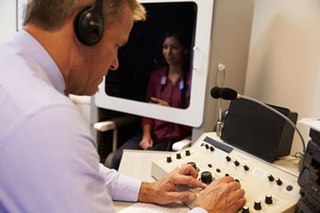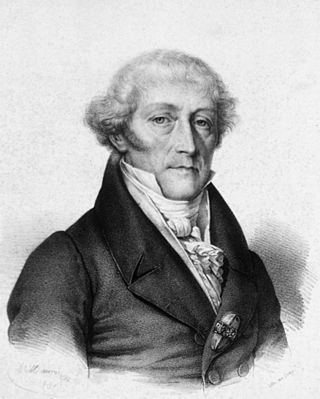
Edward Lee Thorndike was an American psychologist who spent nearly his entire career at Teachers College, Columbia University. His work on comparative psychology and the learning process led to the theory of connectionism and helped lay the scientific foundation for educational psychology. He also worked on solving industrial problems, such as employee exams and testing.
Bone conduction is the conduction of sound to the inner ear primarily through the bones of the skull, allowing the hearer to perceive audio content even if the ear canal is blocked. Bone conduction transmission occurs constantly as sound waves vibrate bone, specifically the bones in the skull, although it is hard for the average individual to distinguish sound being conveyed through the bone as opposed to the sound being conveyed through the air via the ear canal. Intentional transmission of sound through bone can be used with individuals with normal hearing — as with bone-conduction headphones — or as a treatment option for certain types of hearing impairment. Bones are generally more effective at transmitting lower-frequency sounds compared to higher-frequency sounds.

Audiology is a branch of science that studies hearing, balance, and related disorders. Audiologists treat those with hearing loss and proactively prevent related damage. By employing various testing strategies, audiologists aim to determine whether someone has normal sensitivity to sounds. If hearing loss is identified, audiologists determine which portions of hearing are affected, to what degree, and where the lesion causing the hearing loss is found. If an audiologist determines that a hearing loss or vestibular abnormality is present, they will provide recommendations for interventions or rehabilitation.

Conductive hearing loss (CHL) occurs when there is a problem transferring sound waves anywhere along the pathway through the outer ear, tympanic membrane (eardrum), or middle ear (ossicles). If a conductive hearing loss occurs in conjunction with a sensorineural hearing loss, it is referred to as a mixed hearing loss. Depending upon the severity and nature of the conductive loss, this type of hearing impairment can often be treated with surgical intervention or pharmaceuticals to partially or, in some cases, fully restore hearing acuity to within normal range. However, cases of permanent or chronic conductive hearing loss may require other treatment modalities such as hearing aid devices to improve detection of sound and speech perception.

Audiometry is a branch of audiology and the science of measuring hearing acuity for variations in sound intensity and pitch and for tonal purity, involving thresholds and differing frequencies. Typically, audiometric tests determine a subject's hearing levels with the help of an audiometer, but may also measure ability to discriminate between different sound intensities, recognize pitch, or distinguish speech from background noise. Acoustic reflex and otoacoustic emissions may also be measured. Results of audiometric tests are used to diagnose hearing loss or diseases of the ear, and often make use of an audiogram.
The Doctor of Audiology is a professional degree for an audiologist. The AuD program is designed to produce audiologists who are skilled in providing diagnostic, rehabilitative, and other services associated with hearing, balance, tinnitus management, and related audiological fields. These individuals help patients with hearing problems primarily by diagnosing hearing loss and fitting hearing assistive devices.

Antonio Scarpa was an Italian anatomist and professor.

An audiogram is a graph that shows the audible threshold for standardized frequencies as measured by an audiometer. The Y axis represents intensity measured in decibels (dB) and the X axis represents frequency measured in hertz (Hz). The threshold of hearing is plotted relative to a standardised curve that represents 'normal' hearing, in dB(HL). They are not the same as equal-loudness contours, which are a set of curves representing equal loudness at different levels, as well as at the threshold of hearing, in absolute terms measured in dB SPL.

A bone-anchored hearing aid (BAHA) is a type of hearing aid based on bone conduction. It is primarily suited for people who have conductive hearing losses, unilateral hearing loss, single-sided deafness and people with mixed hearing losses who cannot otherwise wear 'in the ear' or 'behind the ear' hearing aids. They are more expensive than conventional hearing aids, and their placement involves invasive surgery which carries a risk of complications, although when complications do occur, they are usually minor.
Salus University is a private university in Elkins Park, Pennsylvania, specializing in degree programs for the health care professions.
Auditory integration training (AIT) is a procedure pioneered in France by Guy Bérard, who promoted it as a cure for clinical depression and suicidal tendencies, along with what he said were very positive results for dyslexia and autism, although there has been very little empirical evidence regarding this assertion. It typically involves 20 half-hour sessions over 10 days listening to specially filtered and modulated music. It was used in the early 1990s as a treatment for autism; it has been promoted as a treatment for ADHD, depression, and a wide variety of other disorders. AIT has not met scientific standards for efficacy that would justify its use as a treatment for any condition.
Auditory processing disorder (APD), rarely known as King-Kopetzky syndrome or auditory disability with normal hearing (ADN), is a neurodevelopmental disorder affecting the way the brain processes sounds. Individuals with APD usually have normal structure and function of the ear, but cannot process the information they hear in the same way as others do, which leads to difficulties in recognizing and interpreting sounds, especially the sounds composing speech. It is thought that these difficulties arise from dysfunction in the central nervous system. This is, in part, essentially a failure of the cocktail party effect found in most people.
Marion Downs was an American audiologist and Professor Emerita at the University of Colorado Health Sciences Center, Denver, who pioneered universal newborn hearing screening in the early 1960s, then spent more than 30 years trying to convince her peers to adopt the testing in hospitals and to place hearing aids on infants who showed hearing loss. She worked to alert the medical world to the developmental problems associated with childhood deafness. As a result of her efforts, 95 percent of all newborns in America today are screened for hearing loss. She devoted her professional life to the promotion of early identification of hearing loss in newborns, infants, and young children and to helping deaf and hard of hearing individuals lead fulfilling lives.
Tele-audiology is the utilization of telemedicine to provide audiological services and may include the full scope of audiological practice.
Leo G. Doerfler (1919–2004) was the founder of the profession of audiology, the science of hearing and hearing disorders, in the early 1940s. He played a leading role in establishing professional bodies and educational standards for audiology practitioners.

Real ear measurement is the measurement of sound pressure level in a patient's ear canal developed when a hearing aid is worn. It is measured with the use of a silicone probe tube inserted in the canal connected to a microphone outside the ear and is done to verify that the hearing aid is providing suitable amplification for a patient's hearing loss. The American Speech–Language–Hearing Association (ASHA) and American Academy of Audiology (AAA) recommend real ear measures as the preferred method of verifying the performance of hearing aids. Used by audiologists and other hearing healthcare practitioners in the process of hearing aid fitting, real ear measures are the most reliable and efficient method for assessing the benefit provided by the amplification. Measurement of the sound level in the ear canal allows the clinician to make informed judgements on audibility of sound in the ear and the effectiveness of hearing aid treatment.
Ira Hirsh was an American psychologist who made early contributions to the field of audiology. He was the Edward Mallinckrodt Distinguished University Professor of Psychology and Audiology at Washington University in St. Louis (WUSTL) and served as president of the Acoustical Society of America.
Cartilage conduction is a pathway by which sound signals are transmitted to the inner ear. In 2004, Hiroshi Hosoi discovered this pathway and named “cartilage conduction”. Hearing by cartilage conduction is distinct from conventional sound-conduction pathways, such as air or bone, because it is realized by touching a transducer on the aural cartilage and does not involve the vibration of the skull bone. Therefore, cartilage conduction is referred to as the “third auditory pathway”.

Brian C.J. Moore FMedSci, FRS is an Emeritus Professor of Auditory Perception in the University of Cambridge and an Emeritus Fellow of Wolfson College, Cambridge. His research focuses on psychoacoustics, audiology, and the development and assessment of hearing aids.
Sandra Gordon-Salant is an American audiologist. She is a professor at the University of Maryland, College Park, where she is also director of the doctoral program in clinical audiology. Gordon-Salant investigates the effects of aging and hearing loss on auditory processes, as well as signal enhancement devices for hearing-impaired listeners. She is the senior editor of the 2010 book, The Aging Auditory System. Gordon-Salant has served as editor of the Journal of Speech, Language, and Hearing Research.









